Saturday was my local California Native Plant Society’s annual plant sale.
Eight hours on my feet, volunteering, had me pretty exhausted, but not too exhausted to shop! Still, I thought Saturday’s haul showed remarkable focus and restraint–except for one plant.
I’ve threatened to start a collection of dudleyas, that cool mostly-California genus of rosette-forming succulents. I have several species in the garden already, and I’ve always been struck by the subtle variations between the different kinds. I think that you can make out some of the differences pretty easily in the big group photo above, though a couple are immature plants and will look a little more like their relatives when grown up.
So here are the new additions:
Dudleya abramsii, Abrams’ dudleya.
Orcutt’s dudleya, D. attenuata ssp. orcuttii.
Britton’s dudleya, D. brittonii, a Baja species, probably one of the biggest, splashiest of this genus.
Candle holder live-forever, D. candelabrum, another of the larger, more charismatic species. This hails from the Channel Islands off Santa Barbara.
Bright green dudleya, D. virens ssp. hassei (also called D. hassei). The “bright green” in this Catalina Island species appears to be a misnomer since my plant looks really white or blue-green, as do the photos up on CalPhotos.
Sticky dudleya, D. viscida, a plant only found in the low southern end of the state.
Looking at the first photo you’ll probably notice a plant that looks nothing like a dudleya. That plant is thick-leaved yerba santa, Eriodichtyon crassifolium. With a reputation for spreading when it’s happy, this isn’t a plant for every garden. There’s a spot behind the back fence on the slope garden where there’s a tangle of iceplant and ivy. If any plant stands a chance against those two nemeses it might be this one. I’ve loved its lavender flowers in the spring and the strikingly modern upright growth habit. It’ll give me more excuses to tend this little wasteland of a garden space, my little secret garden with big, scary datura flowers and the even scarier iceplant and ivy.

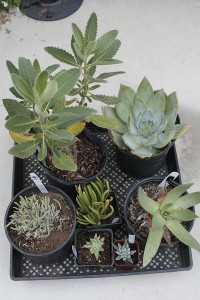
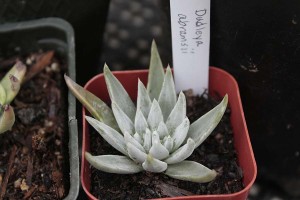


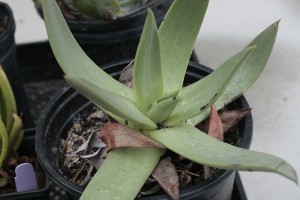
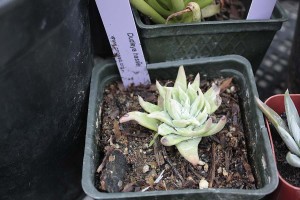
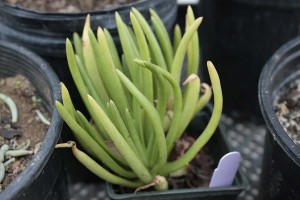
Sweet little native pups… it is fun to imagine what they will look like all grown up. Very dramatic. ;>)
Those dudleyas look great!
Is very interesting to see all the subtle differences
I’m a big dudleya fan, with four or five species in our garden. It seems like a genus you would like, and I was surprised at one point when you said you didn’t have many. It’s a nice haul; may they pup widely.
i really like your choice of plants. i grow lots of dudleyas here in the bay area – including some tiny, unnamed ones i’ve been propagating for a long time. remember that most dudleyas do better in bright shade than full sun. the d. brittonii and d. candelabrum look amazing in large pots, w/ a thick mulch of smooth pebbles.
Nice! Have you ever grown Dudleya cymosa? I haven’t, but it’s the only one that grows in my vicinity, so I’ve been thinking that I’ll try it if I ever see it for sale.
Your natives are my exotics! Love all of them!
I echo Tatyana’s comment. While I’m preparing to overwinter my one Dudleya indoors your buying them as natives! Oh and I love the “Candle holder live-forever” the name and the look of it. Glad you still had the energy to shop!
Very cool! You did indeed show restraint for all your effort of working the sale.
Carol, there’s definitely lots to look forward to with these. Since even mature plants of most of these are still on the smaller side I think I’ve finally found a genus that I can make a collection out of.
~Fer, I agree, the subtle variation is great, and I’d like to find a way to display them near each other so that you can better appreciate the variety.
Ryan, thanks! I still have the first dudleya I bought about 20 years ago, so I’m optimistic these will do well for me. It helps that many fo them come from right here in this county.
Pete, thanks for the tips! I’ve grown other dudleyas in pots before and they did great. I could see how the two larger species would look really dramatic in a pot.
Gayle, no, I haven’t grown D. cymosa. It grows in my county too, and is on my list of species to try to get soon. It has the bonus of having strongly colored flowers, unlike some of the others.
Tatyana, thank you! Even though I can find plants in the wild a short distance from my house I still find them very exotic looking.
Loree, I think D. candelabrum is the most dangerously pointed and the one most like to appeal to your danger-garden tendencies. It’s one of my favs already.
Tina, after working so hard it’d have been hard not to treat myself at least a little bit. My society sold over 5,000 plants that day, so a few others at the sale didn’t show quite my level of restraint.
I started dabbling in Dudleyas only about 3 years ago and have 8 different species so far, but they do not include any of the ones you’ve pictured above. Dang! Wish I had gone to your plant sale (CNPS San Diego Chapter, I presume?) I also learned the hard way that Dudleyas are apparently the ‘piece de resistance’ in the never ending salad bar of our wascally wabbits. My first plantings became the victims of rabbit predation, so I’ve learned to cage them all in chicken wire – rather ugly, but effective.
I learned a lot from this post and the comments. I just planted some Dudleya cymosa in the pool garden and it’s my first dabble in the area of succulents. Light shade – ooh dear. We’ll see how they do where I put them I guess! Wascally wabbits – well hopefully not in the fenced-in pool area. I saw a big succulent patch in a garden on the native garden tour this year and the owner said rabbits only ravaged the young plants – his bed was not protected. So there is hope?
I love our native Dudleya. My favorite is to plant them in colorful containers and then mulch them with a complimentary color of aquarium gravel. In pots you can also move them around to find the best suited filtered light for their needs. Thanks for the great post.
Doggone it, James…why did you have to bring my attention to a new plant to obsess over?
Arleen, I’m glad my main dudleya predators are snails and–mostly–slugs. With a species named Dudleya edulis, I guess it shouldn’t be a surprise the genus ends up being tasty to not just humans. Yes, my sale was the San Diego chapter. There were 2-3 other species to choose from that I already had, but in the frenzy many sold out within an hour. The Rancho Santa Ana sale might be a cool place to try next month for a few more species…
CM, if it’s any consolation my two oldest local dudleays specimens that I’ve grown for years bask in sunshine most of the day, though they’re in the ground and not in pots. They look a little dried up in the summer, but they begin to bounce back this time of year. The chance to set down deeper roots in the ground probably helps them get through more sunny days.
Julie, I can see having fun with different colors of gravel since the plants are so neutral in color. And a nice advantage of having them potted is that you can show them off when they bloom.
Ricki, as Loree pointed out, where you are isn’t as friendly to dudleyas as it is down here in the subtropics. But what harm would one or two new houseplants do?